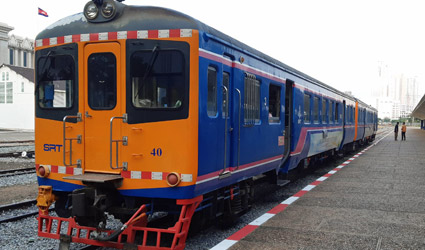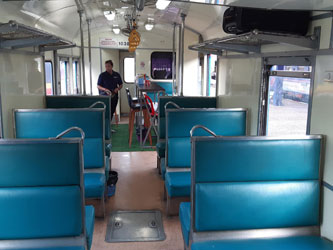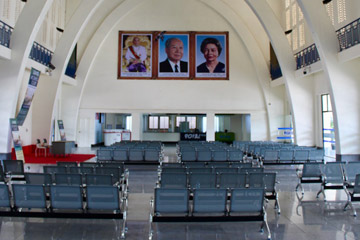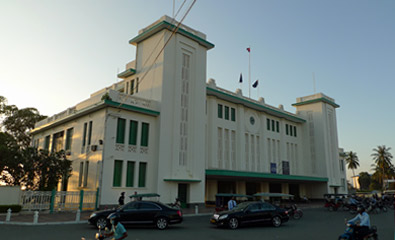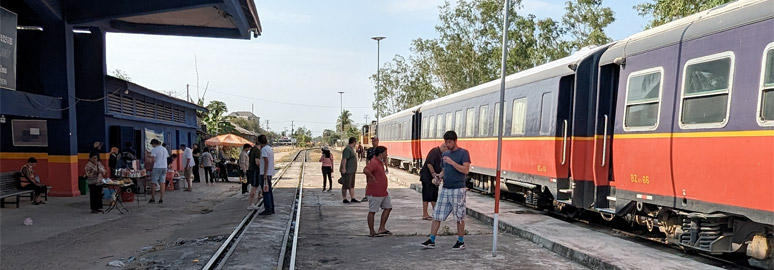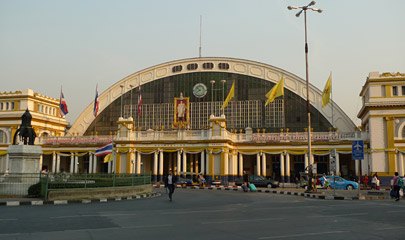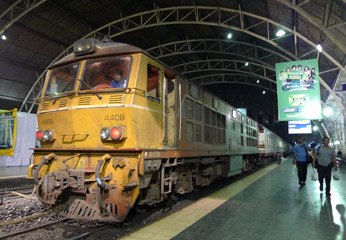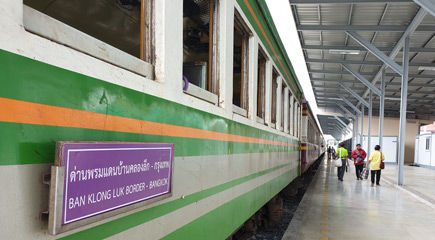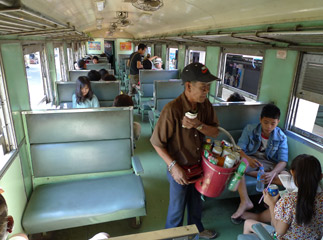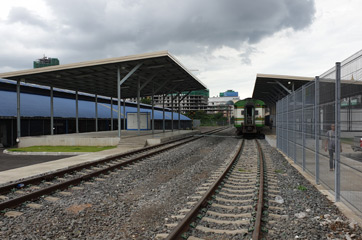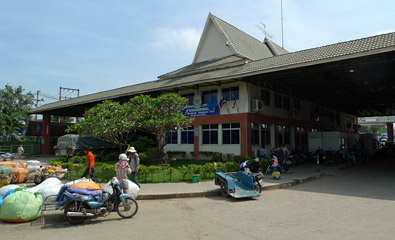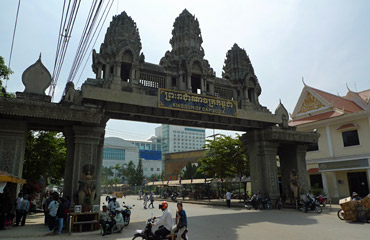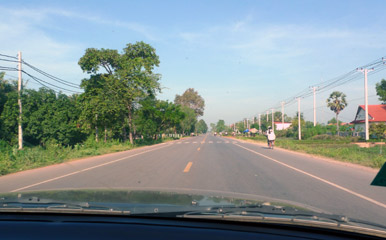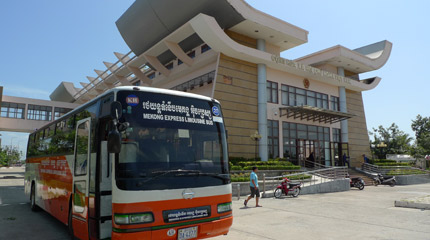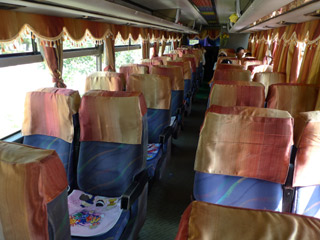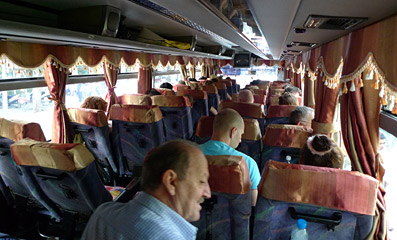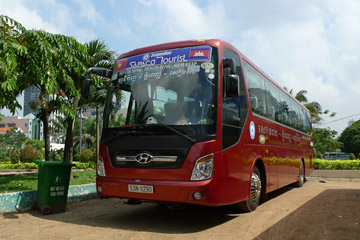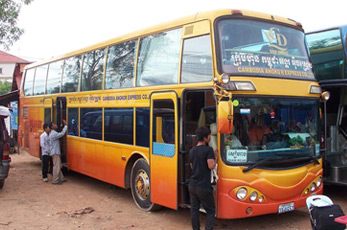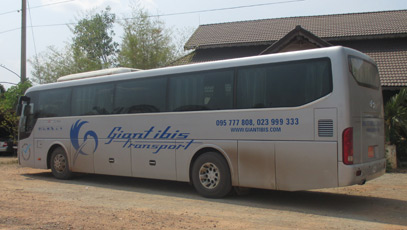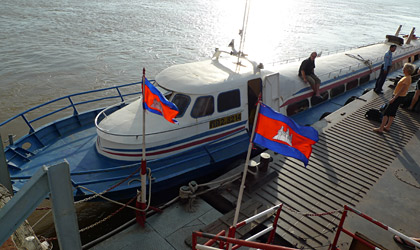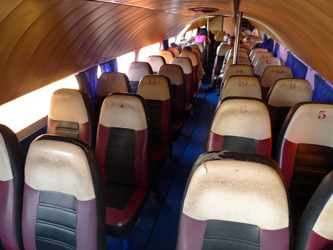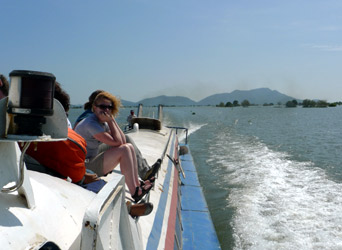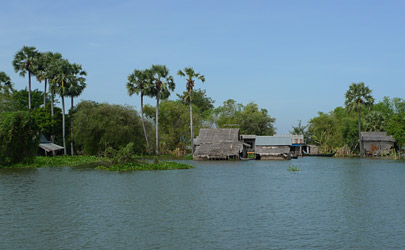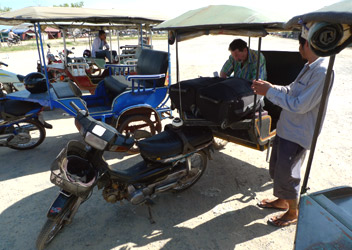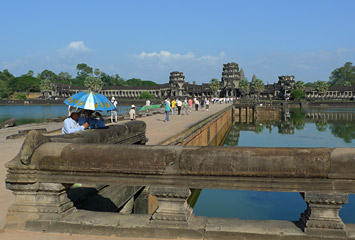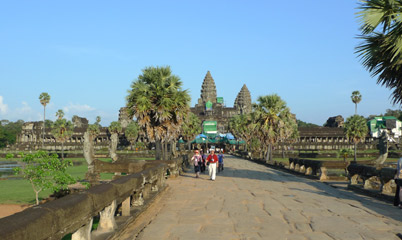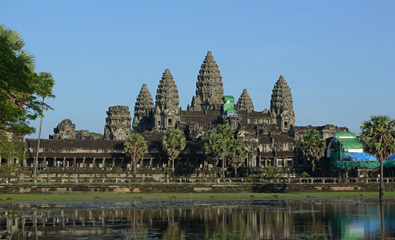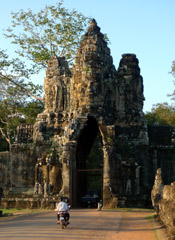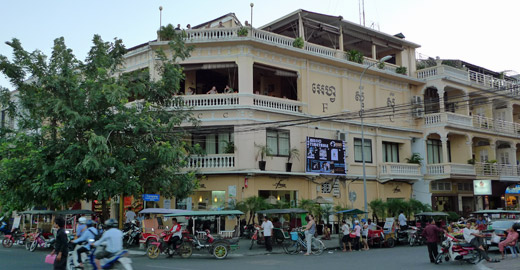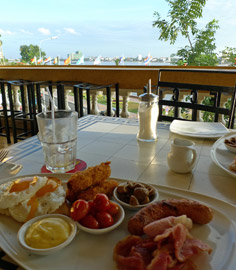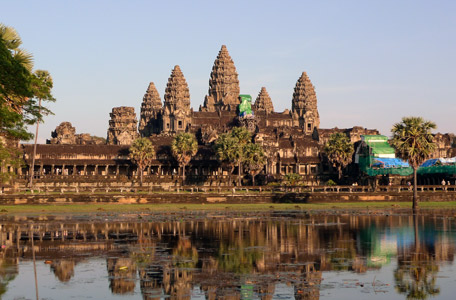 |
|
|
Angkor Wat, Cambodia's premier visitor attraction. |
|
|
Click for an interactive bus, train, ferry route map of SE Asia |
Siem Reap & Phnom Penh overland
Cambodia now has a domestic train service between Phnom Penh, Kampot, Sihanoukville & Battambang, and there are bus links to Bangkok & Saigon (Ho Chi Minh). As always, overland travel is far more interesting than flying and much better for the environment. The journeys will be as much part of your travel experience as the destinations. This page helps you plan overland journeys by bus & train to, from and within Cambodia.
Travel to & from Cambodia
![]() Bangkok - Saigon (Ho Chi Minh)
by train & bus
Bangkok - Saigon (Ho Chi Minh)
by train & bus
![]() Bangkok
- Siem Reap - Phnom Penh by train & bus
Bangkok
- Siem Reap - Phnom Penh by train & bus
![]() Saigon - Phnom Penh - Siem Reap by bus
Saigon - Phnom Penh - Siem Reap by bus
![]() Europe
to Cambodia by Trans-Siberian railway
Europe
to Cambodia by Trans-Siberian railway
Travel within Cambodia
![]() Phnom Penh - Battambang - Poipet by train
Phnom Penh - Battambang - Poipet by train
![]() Phnom Penh - Kampot - Sihanoukville by train
Phnom Penh - Kampot - Sihanoukville by train
![]() Phnom Penh - Siem Reap by bus
Phnom Penh - Siem Reap by bus
![]() Phnom Penh - Siem Reap by speedboat
Phnom Penh - Siem Reap by speedboat
![]() Phnom Penh - Battambang by bus
Phnom Penh - Battambang by bus
![]() Phnom Penh - Sihanoukville by bus
Phnom Penh - Sihanoukville by bus
![]() Phnom Penh - Kampot by bus
Phnom Penh - Kampot by bus
Other useful information
![]() Useful country information -
currency, visas, etc.
Useful country information -
currency, visas, etc.
![]() Hotels in Phnom Penh, Siem Reap & Cambodia
Hotels in Phnom Penh, Siem Reap & Cambodia
![]() Train
travel Bangkok - Kuala Lumpur - Singapore
Train
travel Bangkok - Kuala Lumpur - Singapore
Useful country information
Train service in Cambodia
By 2006 there was just one train service remaining in Cambodia, between Battambang & Phnom Penh running every second day. It was cut back to just once a week, then stopped running altogether in 2009. From 2009 until 2016 there were no regular passenger trains in Cambodia at all.
However, Cambodian & foreign backers have brought Cambodia's railways back from the dead. A company called Toll Royal Railway was originally given a 30 year concession to repair and operate the railway, and in 2013 it was planned to reopen both the Southern Line from Phnom Penh to Kampot & Sihanoukville (254 km) and the Northern Line from Phnom Penh to Battambang, Sisophon & Poiphet on the Thai border (388 km). Indeed, I witnessed the new ballast and sleepers being laid between Sisophon and Poipet in late 2011. Problems arose, Toll pulled (or was pushed) out, but a new concession was let and passenger trains have resumed on two routes.
Phnom Penh - Battambang - Poipet
Train service on the western line between Phnom Penh, Pursat, Battambang, Sisophon and Poipet on the Thai border resumed in July 2018. Services were then suspended during the pandemic, in 2023 a train is running between Phnom Penh & Battambang every day, but service to Poiphet is still temporarily suspended. You can check this information at royalrailway.easybook.com. Feedback appreciated.
* = Train service to Poiphet temporarily suspended due to Covid-19, still suspended in 2023.
Check current status at royalrailway.easybook.com or www.facebook.com/TRRCambodia or www.facebook.com/groups/TrainCambodia.RR.
How to buy tickets
You can buy tickets online from reliable ticketing agency www.baolau.com.
Or buy online at royalrailway.easybook.com, at the station or by phone on +855 78 888 582-83.
In Phnom Penh, the station ticket office is open 08:00-16:30 weekdays, 06:00-16:00 weekends.
What's the train like?
The train used for the Phnom Penh-Battambang service in 2022 was an ex-State Railways of Thailand diesel railcar with opening windows & fans, but no air-con.
Traveller's report
Traveller David Cooper reports from a trip in 2022: "Booked successfully beforehand via Royal Railways website, goes via EasyBook. Only problem, as is common with Cambodia was inability to use US credit cards (same with visa website), but UK cards fine.
The email confirmation says to check in at desk 30 minutes beforehand, but the kiosk was swamped with locals buying last minute tickets for both trains. Kiosk attendants said don’t bother, email on phone is enough for the train. Ticket inspector/guard/food counter attendant (same person) just took photo of phone, that was enough. Fares were also taken on the train. There was seat selection on the booking website, but it was irrelevant in practice: Seat selection was for a 4 car train, actually only two. No seat numbers, just sit anywhere. Busy but not full.
Confusion at the station as both trains leaving fairly close together, no signage, and conflicting / incorrect information from staff resulting in many people, including locals getting on and off trains. The Kampot train wasn’t actually in the station until just before the Battambang train left, (times as on the website), so Kampot passengers got on the Battambang train and Battambang passengers told to get off and wait for another train. All worked out fine in the end, Battambang train left on time so obviously the right one. Emptied of most supplies by shortly after departure."
Phnom Penh - Kampot - Sihanoukville
A successful trial passenger service ran during a holiday week between Phnom Penh & Sihanoukville in April 2016, and a permanent daily service on this route now runs as shown below. Please check times locally.
Sometimes the trains consists of 1 or 2 air-conditioned cars hauled by a locomotive with car & motorcycle carriers attached, car transport $10. Other departures consist of a single-car diesel railcar newly built in Mexico. There seems to be little consistency.
How to buy tickets
You can buy tickets online from reliable ticketing agency www.baolau.com.
Or buy online at royalrailway.easybook.com, at the station or by phone on +855 78 888 582-83.
In Phnom Penh, the station ticket office is open 08:00-16:30 weekdays, 06:00-16:00 weekends.
In Kampot, the station ticket office is open 08:00-16:00 Wed, Thur, Fri, Sat, Sun, Mon. Closed Tuesdays.
In Sihanoukville, the station ticket office is open 06:00-16:00 Sat & Sun, 08:00-16:30 Mon, Wed, Thurs, Fri, closed Tuesdays.
Do tickets sell out? Yes! Tickets only go on sale at the ticket office one week before departure, all tickets include a numbered seat so places often sell out by the time departure day arrives. In this honeymoon period with the train recently reinstated, it's reported that all seats are sold out by the Wednesday or Thursday for the following Saturday & Sunday.
What's the train like?
Traveller's reports
Traveller Amy Vaughan reports (2024): "I took the 7am Phnom Penh to Sihanoukville train. I booked online and the ticket said to check in at the kiosk 30 minutes before departure. I was basically laughed away by the nice station staff "this print out is your ticket no need to exchange". It's an outside Stn, two platforms and a glorified portacabin office. Decent toilets. No shops but a couple of people roaming selling nice looking baguettes and plastic pots of rice dishes. The seating plan online and seat allocation on ticket bore no resemblance to the 3 carriage train that was there. Two carriages with bench seating lengthways (so you'd be travelling sideways) and one carriage with forward /backwards seating. Air con present but not cold. Toilet and basin worked until a few hours in when it ran out of water. Scenery is interesting and two short stops at stations (9am and 11ish) for coffee and snacks from small stalls on the platform. Train toots the horn to get you all back on board. At Sihanoukville there is the usual tuk tuk scrum touting to get to the port for the boat for Koh Rong."
Traveller Graham Roberts reports: "We took the train from Kampot to Phnom Penh. The ticket does specify a seat number but when we got on the train, the conductor said those seat numbers did not exist and in any case everyone was just sitting wherever. The conductor spoke very good English. The two carriages were about 40% occupied. We enjoyed the trip greatly, the views are so nice compared to the roadside scenery. The seats were quite comfortable, nicely padded. The rolling stock was French. Good food was available at each station where everyone seems to get out and stretch their legs. One problem with the new service has been a fair few collisions with road traffic. Cambodian rules of the road permit anyone driving a large truck or expensive SUV to consider themselves deserving of priority over other traffic. It's taking them a while to understand this does not work with trains that cannot stop easily! So far, however, no rail passengers or staff have been injured. The main source of casualties on the new line seems to involve people who get drunk and consider the line to be a good place to take a nap."
Bangkok - Saigon
Overview of travel between Thailand & Vietnam, across Cambodia
It's easy to travel between Bangkok in Thailand and Saigon (Ho Chi Minh City) in Vietnam overland across Cambodia. It's cheap, and there's a lot to see on the way. There are several ways to break up the journey, so here is a summary of the options. Most travellers will want to go via Siem Reap to see the world-famous temples at Angkor nearby, and Phnom Penh is undoubtedly worth a stop as well.
Bangkok ► Saigon
Option 1, the fastest journey from Bangkok to Saigon taking 2 days, 1 night. Cost around $40 excluding hotels.
-
Day 1, take the morning train from Bangkok to Ban Klong Luk, walk across the border into Poipet and take a bus or taxi to Siem Reap as shown in detail below.
-
Stay overnight in Siem Reap. Hotels are inexpensive by western standards, consider the Heritage Suites Hotel or the FCC Angkor, the latter converted from a French governor's residence.
-
Day 2, take a morning bus from Siem Reap to Saigon (Ho Chi Minh), arriving in the early evening, see here for details.
-
However, doing this route in just 2 days won't give you any time to see the Angkor temples, so I'd suggest extending the journey to 3 days to give 2 nights and one full day in Siem Reap to visit Angkor.
Option 2, a less hectic option taking 3 days, 2 nights. Cost around $65 excluding hotels.
-
Day 1, take the morning train from Bangkok to Ban Klong Luk, walk across the border into Poipet and take a bus or taxi to Siem Reap as shown in detail below.
-
Stay overnight in Siem Reap. Hotels are inexpensive by western standards, consider the Heritage Suites Hotel or the FCC Angkor, the latter converted from a French governor's residence.
There's time for a quick tour of the Angkor temples, but I'd recommend stretching the trip to 4 days and spending 2 nights and one full day in Siem Reap.
-
Day 2, take a bus from Siem Reap to Phnom Penh taking 6½ hours, details here.
-
Stay overnight in Phnom Penh. I highly recommend staying at the Foreign Correspondents Club.
-
Day 3, take a bus from Phnom Penh to Saigon, see here for details.
Saigon ► Bangkok
Option 1, the fastest journey from Saigon (Ho Chi Minh) to Bangkok taking 2 days, 1 night. Cost around $40 excluding hotels.
-
Day 1, travel from Saigon to Siem Reap on a direct morning bus, see here for details.
-
Stay overnight in Siem Reap. Hotels are inexpensive by western standards, consider the Heritage Suites Hotel or the FCC Angkor, the latter converted from a French governor's residence.
-
Day 2, take a bus or taxi to the border at Poipet, walk across the border and take the afternoon train from Ban Klong Luk to Bangkok, as shown in detail below.
-
However, this doesn't give you any time to see the famous Angkor temples, so I'd suggest extending the journey to 3 days to give 2 nights and one full day in Siem Reap to visit Angkor.
Option 2, a less hectic option taking 3 days, 2 nights. Cost around $65 excluding hotels.
-
Day 1, travel from Saigon to Phnom Penh on a direct morning bus taking 6½ hours, see here for details.
-
Stay overnight in Phnom Penh. I highly recommend staying at the Foreign Correspondents Club.
-
Day 2, travel from Phnom Penh to Siem Reap by bus, journey time 5 hours, see here for details.
-
Stay overnight in Siem Reap. Hotels are inexpensive by western standards, consider the Heritage Suites Hotel or the FCC Angkor, the latter converted from a French governor's residence.
There's time for a quick tour of the Angkor temples, but I'd recommend stretching the trip to 4 days and spending 2 nights and one full day in Siem Reap.
-
Day 3, in the morning take bus or taxi to the border at Poipet, walk across the border then take the afternoon train from Ban Klong Luk to Bangkok as shown in detail below.
Bangkok - Siem Reap & PP.
Bangkok to Angkor Wat by train & bus
You can travel by train & bus from Bangkok to Siem Reap for the famous Angkor temples for as little as $13, no prior reservation needed, just turn up any day you like, buy a train ticket and off you go. And the journey itself is an adventure.
Once in Siem Reap there are buses or (if it's running) an exhilarating speedboat to Phnom Penh. Bangkok to Phnom Penh from $26.
Although there are direct buses from Bangkok to both Siem Reap and Phnom Penh, this train-bus combo is a much nicer way to go than spending whole days in a cramped bus seat. There used to be a railway between Bangkok and Phnom Penh, but since the war in Cambodia it's only been running between Bangkok and the Thai side of the Cambodian border - although another section is now operational within Cambodia.
Update: Work to restore the complete Phnom Penh-Bangkok rail link is almost complete. In July 2019 the existing Bangkok-Aranyaprathet trains were extended 5 km to Ban Klong Luk on the border a mere 200m walk from the Thai border checkpoint and 500m from Poipet. Train service between Poipet and Phnom Penh resumed in July 2018, see the train travel section above, although the Poipet-Battambang section was suspended during the pandemic and has not yet resumed.
Covid-19 update: International services may be affected by Covid-19 restrictions. Train service to/from Poiphet is suspended.
Bangkok ► Siem Reap ► Phnom Penh
-
Day 1, travel from Bangkok to Ban Klong Luk by train, leaving Bangkok Hualamphong at 05:55 daily & arriving Ban Klong Luk 11:17.
There's also a 13:05 train from Bangkok arriving Ban Klong Luk at 17:27.
The fare is 49 baht (£1 or $1.60), no reservation necessary, turn up, buy a ticket at the station and hop on - yes, the ticket office will be open!
They may offer you a combined train+bus ticket to Siem Reap, but just buy the train ticket to stay flexible with onward transport.
Bangkok to Ban Klong Luk is 260 km, 161 miles. The train is 3rd class only, but it's clean, spacious and it's a really pleasant and enjoyable ride, clickety clacking along with a breeze blowing through the open window. The train was extended beyond Aranyaprathet to Ban Klong Luk Border in July 2019.
Useful tip: The train also calls at Phaya Thai station at 06:10 (next to the Phaya Thai BTS Skytrain station) and Makkasan station at 06:20 (Makkasan railway station is not the same as the Airport Rail Link's Makkasan station, make that clear to your taxi driver). Boarding at these stations can be more convenient if you're staying in northern Bangkok.
-
Day 1, walk across the border into Cambodia.
It's a 200 metre walk from Ban Klong Luk station to the Thai border checkpoint. The border is open 07:00-20:00.
Cambodian visas can be bought there for around $30 if you haven't bought a Cambodian e-visa beforehand. First get your passport stamped at the Thai side, then walk on for 100m under the Angkor - Welcome to Cambodia archway to the Cambodian border post to buy your Cambodian visa, have your fingerprints scanned and your passport stamped.
Be careful with your valuables when crossing the border, just in case there are pickpockets around. The whole process should only take around 30 minutes, but at busy times it can take an hour, sometimes more.
At the exit from Poipet border post onto the big roundabout, you will see (or be guided to) an official free transit bus to the 'Poipet Tourist Passenger International Terminal' 10 minutes down the road from where all the share taxis and buses leave for Siem Reap or Battambang or Phnom Penh. This shuttle bus (and the man with the official badge who guides you to it) is legitimate.
-
Day 1, take a bus, minivan or share taxi from Poiphet to Siem Reap.
The 152 km (95 miles) from Poipet to Siem Reap takes 2½ hours by share taxi or 3 hours by bus now that the highway has been improved.
Prices are posted at the ticket counter at the Poipet Tourist Passenger International Terminal. A shared taxi costs $12 for a seat or $48 for the whole car. A bus costs $9, minivan $10. You may also be approached by taxi drivers outside the border post, perhaps $40 for a taxi all the way to Siem Reap.
If you left Bangkok at 05:55, you should reach Siem Reap by 15:30.
If you left Bangkok at 13:05, you should reach Siem Reap by 22:30.
-
Stay in Siem Reap for at least 1 night. Hotels are inexpensive by western standards, consider the Heritage Suites Hotel or the FCC Angkor, the latter converted from a French governor's residence. Ideally, spend 2 nights and visit the famous Angkor temples.
-
Day 2 (or Day 3), travel from Siem Reap to Phnom Penh by bus or speedboat.
When you're ready to move on, buses leave Siem Reap at various times from 06:30 until about 12:30. Journey time 6½ hours, fare $13-$15, distance 314 km, see below for details. Buses are run by several operators. Some buses are double-deck, some have a WC & refreshments.
If there are sufficient tourists and if water levels make the river navigable, a speedboat leaves Siem Reap at 06:30 and arrives Phnom Penh at 13:00, 251km along the river, fare $35, see below for details. The speedboat journey is a delight, but it may not be running at the moment.
Phnom Penh ► Siem Reap ► Bangkok
-
Day 1, travel from Phnom Penh to Siem Reap by bus or speedboat.
There are various bus departures from early morning until early afternoon, the bus takes 6½ hours & costs $13-$15, see below for details. Buses are run by several operators. Some buses are double-deck, some have a WC & refreshments.
If there are sufficient tourists and if water levels make the river navigable, a speedboat links Phnom Penh with Siem Reap daily taking 6.5 hours, 251km along the river, fare $35, see below for details. The speedboat journey is a delight, but it may not be running at the moment.
-
Stay in Siem Reap for at least 1 night. Hotels are inexpensive by western standards, consider the Heritage Suites Hotel or the FCC Angkor, the latter converted from a French governor's residence. Ideally, spend 2 nights and visit the famous Angkor temples.
-
Day 2, travel from Siem Reap to Poipet by bus, taxi or private car.
In the morning take a private car, bus or share taxi from Siem Reap to Poiphet on the Thai frontier, it's around 152 km or 95 miles.
A private car costs around $25 for 1 passenger for the whole vehicle, $40 for 2 passengers, and takes around 2 hours 25 minutes so you can normally safely leave just before 09:00.
An air-conditioned bus takes around 3 hours with departures from Siem Reap bus station (3 km east of the town centre) at 07:30 and 08:30, fare $9, with free hotel pick up prior to those departure times.
You can buy bus tickets or arrange a private car at any of the many travel agencies around town the day before departure. At busy times of year (for example before and after Thai or Cambodian national holidays), crossing the border can take much longer, sometimes an hour or two, and you may want to leave significantly earlier than suggested here.
-
Day 2, walk across the border from Poipet into Thailand.
You'll be dropped at the entrance to the border point at Poipet. Complete the passport stamping and fingerprint scanning at the Cambodian departures office at the border entrance, then walk through the border, past the casinos, under the Cambodian Angkor arch to the Thai border point 100m ahead. Fill out a Thai arrivals card and get your passport stamped here and emerge from the border. The whole process should only take around 25 minutes, although at busy times of year it can take an hour or even two. The border is open 07:00-20:00.
Once across the border, walk 200 metres from the Thai border point to Ban Klong Luk station. In fact, it's literally on the other side of the road from the Thai border office, but not very well signed, so look closely!
-
Day 2, travel from Ban Klong Luk to Bangkok by train.
Two reliable trains a day run from Ban Klong Luk to Bangkok, 260 km or 161 miles. You should be able to make the 14:50 departure from Ban Klong Luk arriving Bangkok Hualamphong at 20:25. The other train leaves Ban Klong Luk at 06:58, arriving Bangkok Hualamphong at 12:05.
The fare is 49 baht (£1 or $1.60), no reservation necessary, turn up and buy a ticket at the station, it cannot sell out.
Both trains are 3rd class only, but they are clean and it's a really pleasant ride with a breeze blowing in through the open window. The train also drops off at Makkasan (19:40) and Phaya Thai (19:46) before arriving at Bangkok Hualamphong, these can be more convenient stations at which to get off if you're staying in northern Bangkok. The train was extended to start in Ban Klong Luk rather than Aranyaprathet in July 2019.
Bangkok to Siem Reap in pictures
Travellers' reports
Traveller Ruth Klaase reports: "I stayed at the great Hua Lamphong hostel, located a very convenient 5-minute walk from the station, handy when you have to get up early. The little shops at the station are open, so don't worry about bringing supplies or even having breakfast, it's available. I was at the station at 5 past 5, which meant no line for a ticket, a relaxed breakfast and plenty of seats to choose from. The train fills up at later stations with people standing in the aisles between some stations, so plan your bathroom breaks carefully. You can buy water from people who come by every half an hour. They also sell food: fishcakes, rice with fried egg, and other stuff. My stomach was fine after the fishcakes. The 6-hour ride (it can take slightly longer) is relatively comfortable. You should definitely bring a pillow or something to rest your head against. The scenery is not spectacular, but the countryside is nice to watch from the window. When you arrive at the Aranyaprathet station, tuktuk drivers will immediately offer their service. I walked past some of them, then picked someone who wasn't nagging me, and asked "how much?" He said "80 Baht", which was already less than what I had been told, and other travellers paid a lot more. Also, my tuktuk driver did not try to drop me off in the tout zone, but kindly stopped right around the corner from Thai immigration. If you ask for that straight away I think they will not try to scam you. Thai departure (step 1 of the visa procedure) was a breeze (took 5 minutes). Make sure you get an idea of where the buildings are located (Wikitravel has a handy map, and seat61.com shows pictures of the buildings) so you don't end up in one of the tout zones. Because I did my homework I did not get scammed, and no-one tried either. Other travellers were hassled quite a lot, so know what you need to say: "no thank you, I already have a visa", etc. The guys that give you your Cambodian visa sticker (step 2) are very friendly and helpful, but they did try to get 100 Baht from someone who had already indicated that she had a photo. Bring 30USD for the tourist visa and 100THB extra if you don't have a passport photo for the visa. Then comes step 3: getting your visa sticker stamped. This takes a long time (unless you manage to rush through the other steps ahead of everyone else) because they take everyone's finger prints. Bring water inside as it can get very hot and sticky, and it can easily take 45 minutes before it's your turn. When you come out with your visa, the infamous transportation 'free shuttle bus' nonsense is clearly visible, and many people will try to persuade you to get onto the buses. They don't get too annoying, though, and if you say that you are waiting for someone or are staying in town, they usually leave you alone. Poipet is not an attractive place to hang around in, unless you are a gambler, so why anyone would want to stay there is beyond me. I walked a bit after passing the roundabout (as is recommended) to avoid taking a cartel-owned taxi, but ironically still ended up in one. It was $10 each for me and two others, so in terms of price it doesn't make a big difference, but it's still annoying. They try to drop you off at the 'bus station', but don't fall for this. They were very persistent, telling us that cars can't go into Siem Reap (they can), they didn't know the hotel, etc., but we simply said we wouldn't pay until we were at our hotel. Then it suddenly wasn't a problem and we were dropped off at our hotels. So remember: they don't get aggressive, and when you know what you're doing you won't get ripped off, but it's worth planning this trip carefully to avoid getting ripped off. It's an interesting adventure, but a shame that this is one's first impression of a beautiful and friendly country."
Traveller Cynthia O'Brien travelled from Bangkok to Siem Reap: "Travelling from Bangkok to Siem Reap this way was much easier than I expected, after reading many older stories about this route. I took the 05:55 train from Bangkok to Aranyaprathet, for 48 baht. From the station at Aranyaprathet, I took a tuk-tuk for 60 baht to the border at Poiphet. However, the driver made a detour to a travel agency, which is one of the visa scam places. I already had an e-visa, which I would recommend to avoid the hassle at the border. The salesman at the travel agency wanted me to go into his office to talk to him and asked to see my passport. I refused to hand him my passport and the tuk-tuk driver drove me away quickly when I told other travellers not to get their visa at that place, but to get it from Cambodian immigration at the border, where it will cost less. The biggest change from the older accounts is transportation to Siem Reap from the border. As soon as you cross into Cambodia, there is a stop for a free shuttle bus. Do not hesitate to take this free bus to their nearby travel centre. It is operated by a company that arranges legitimate, hassle free transportation to Siem Reap. The two best choices are a mini-van for $10 per passenger, which leaves as soon as it has nine passengers, or a share taxi for $12 per passenger, which leaves when it has four passengers. The prices are non-negotiable, and you buy your ticket for either option at a ticket window, rather than haggling with a driver. The third option is a public bus that leaves at 2:30pm, for $9. However, I do not know how long the journey takes by bus. Since I was travelling alone, I took the mini-van, which only took about an hour to get nine passengers. The highway is now complete, so the ride only took 2 hours and 20 minutes, which included a 30 minute break at a restaurant. When we arrived in Siem Reap, they brought us to a guest house and asked us if we wanted to look, but there was no pressure. There was nothing wrong with the guest house and it was in a good location, but I already paid for another. Included in the ticket price was a tuk tuk ride to your guesthouse. And if you do not have a guest house, the driver will take you around until you find one that you like."
Traveller Andreas Klein also travelled this way: "We caught the 05:55 train from Bangkok to Aranyaprathet. Tickets are still 48 Baht and are easy to book. I'd recommend getting to the station at around 5 o'clock to get this done. Although only 3rd class is available, the train is really good. It was reasonably clean, the seats are comfortable and there are small fans for every compartment. Additionally, you can open the windows which gives you a nice breath of air. The train ride was very interesting due to the landscape and cities you travel through and the (very friendly) people you meet in the train. Every now and then people come to sell food and drinks. We found it also possible to get some hours of sleep in the train. The way to the border is exactly as you describe on your website: We took a tuk-tuk. I can only recommend getting an e-visa. It was very helpful to avoid getting in contact with all the scams offering other types of visa shortly before you cross the border. The signs to the visa entry point are not the best and hence you might fall for one of the help offers from the scams. To cross the border, just walk along the main road through the entry gate and you will find the visa-checkpoint right at the end on the right side. The entry-process is very easy. Finding a reasonable transportation to Siem Reap cost us about 1.5 hours in the sun and lots of negotiation. Some scammers claimed to be from a governmental organisation and tried to sell far too expensive transportation (US$60 to Siem Reap). Avoid getting caught by them and their "official / governmental" bus and organisation (they all wear nice shirts with a Cambodia emblem, but we are still not sure whether this is real), which will only bring you to their taxi stand. Like you say on your website, reasonable transport by taxi to Siem Reap should be $25, which we managed to achieve by walking along the main road, followed by several taxi drivers, who reduced their fares steadily the closer we came to the bus station. It is about 140km."
Further feedback would be appreciated if you use this route, as information is difficult to come by.
Saigon - Phnom Penh & Siem Reap by bus
There is no railway (at least, not yet) between Saigon & Phnom Penh. However, a number of bus companies each operate a range of daily air-conditioned buses in each direction, taking about 6½ hours (they usually quote 5-6 hours, but assuming 6.5 hours is more realistic). There's no point in flying for such a short trip, as flights on this route are expensive, and they save little time. Flying will take up to 4 hours once travel to and from airports, check-in & baggage reclaim are included. The bus costs less than a tenth of the flight price, and is an insight into Vietnam & Cambodia in a way a globalised flight just isn't.
Saigon to Phnom Penh is 240km, 150 miles.
Use these times as a rough guide as you're often quoted different times in different places. The main 3 operators are shown here, but there are several others. You can check times for multiple operators (including all three shown above) at www.camboticket.com.
The buses operate via Moc Bai (Vietnamese border point) and Bavet (Cambodian border point). Cambodian visas can be bought at the border or you can buy an e-visa in advance at www.evisa.gov.kh.
In Saigon, Kumho Samco, Mekong Express Limousine & Mai Linh buses leave from the bus station at 237 Pham Ngu Lao Street, Ben Nghe Ward, 1Dist, HCMC.
In Phnom Penh, there is no centralised bus station. Mekong Express Limousine leaves from a terminal just out of town, a minibus transfer can be provided from most hotels (it's reported that they no longer have their office at 87 Sisowath Quay at the corner of Street 102 on the riverfront). MaiLinh buses leave from the Olympic stadium. However, some of these bus companies offer a free transfer from your hotel, just ask.
Which bus operator?
Reliable companies operating modern direct buses between Saigon & Phnom Penh include (1) Mekong Express Limousine Bus (catmekongexpress.com), (2) Sapaco Tourist (sapaco.net.vn), (3) Kumho Samco (kumhosamco.com.vn), and (4) Mai Linh. This Tripadvisor link is useful in giving the low-down on each bus company. It's best to avoid the 'budget' operators such as Narin or King who charge $5-$7, use older buses and make you switch buses at the border, taking 7½ hours.
How to buy tickets
You can buy tickets online (and compare prices & times) for multiple operators at either 12go.asia, www.baolau.com or www.camboticket.com. All these agencies are reliable and offer print-your-own online tickets.
Alternatively, you can buy a ticket when you're there, simply by walking into any local travel agency when you get to Phnom Penh or Saigon and asking for a bus ticket. Or ask at your hotel or guest house to arrange a ticket for you. In Saigon you can also try buying tickets from the Sinh Cafe, www.sinhcafe.com. In Phnom Penh, try www.asiavipa.com. There are so many companies and buses, you'll always find a bus with tickets available, even booking the day before you travel.
About the journey
The Mekong Express bus from Saigon typically starts boarding around 20 minutes before departure, across the road from the Mekong Express office on Pham Ngu Lao in central Saigon. Baggage is tagged and loaded under the bus and you're given a luggage receipt. The bus is air-conditioned and there's a clean toilet at the rear. The bus normally leaves promptly, refreshment towels are handed out and then mineral water and a snack. The bus staff collect passports, along with $30 if you haven't got a Cambodian visa. The bus reaches the Vietnamese border at Moc Bai in around 1 hour 55 minutes. Here, everyone leaves the bus, enters the terminal and files towards the passport check where the collected passports are already being stamped. Names are called out, you collect your passport when called, and you leave the building at the far door and rejoin the bus, which by now has pulled forward. When everyone is back on board, the bus drives on 200m to the Cambodian border post at Bavet. Everyone gets off the bus again and enters the building. If you've an e-visa you'll be shown to the e-visa desk to have it checked, then you get fingerprint scanned and passport stamped at the passport desks. The bus leaves when everyone is back on board, around 2 hours 55 minutes into the journey, driving on for 5 minutes past the casinos to a lunch stop at a simple cheap restaurant for around 40 minutes. US dollars, riel and Vietnamese dong are accepted here, and neither the food nor the beer is expensive. Once in Cambodia the landscape changes significantly, from urban ribbon development which has stretched almost all the way from Saigon to the border, to far more rural scenes with rice fields and water buffalo. The architecture also changes, from the Chinese-inspired buildings in Vietnam to temples and shrines more akin to those in Thailand. The bus used to cross the Mekong on ferry at Neak Loeung, but now uses a modern bridge. Expect an arrival in Phnom Penh around 6 hours 30 minutes from Saigon. You may find free WiFi available once the bus enters Cambodia. Don't be surprised if the bus drops you somewhere in your arrival city other than where their website shows the arrival office. This happens regularly!
Travellers' reports
Traveller Jon Feltham took the bus from Saigon to Phnom Penh: "The bus trip from Saigon to PP (about 6 hours ) was with Kumho Samco Buslines. We bought our tickets from a travel agent close to our hotel, but the bus company's offices in Ho Chi Minh city are at 237 Pham Ngu Lao Street, District 1, HCMC. We took a taxi from our hotel to their booking office/travel agent/pick up point, where the coach picked us up. They took our passports and filled the immigration form in to allow us to enter Cambodia, which was a pretty nice touch I thought and saved us routing about for pens and stuff. After the border control formalities, the driver stopped for a spot of lunch 30-45 mins. Then on to PP which included a river crossing by ferry which came as a surprise to us [the ferry has now been replaced by a modern bridge]. The bus company runs a daily service from, Ho Chi Minh City to PP at 07:30 10:30 and 15:00. Ticket prices are $10 US. The busses are pretty modern with air con and have a conductor who rounds everyone up when the bus is ready to move on."
Traveller Kevin Nathan took the bus from Phnom Penh to Saigon: "I bought a ticket from Capital tours below the Capital Guest House, inside the restaurant. The fare from PP to HCMC was US$ 9 for an air conditioned bus. I took a bus which left PP at 06:45 and arrived in HCMC at 13.30. It was a good bus with good service, especially when crossing the immigration. They gave free water, wet face tissue & face mask. We also stopped for lunch before the border. The bus arrived at De Tham Street (a backpacker area) in HCMC."
Saigon to Phnom Penh by river boat
Alternatively, a number of local tour operators run a river boat + bus service from Saigon to Phnom Penh, a very enjoyable way to travel between the two cities. Try www.bigpond.com.kh/users/capitol/opentour.htm.
Phnom Penh - Siem Reap by bus or boat
There are two ways to travel between Phnom Penh and Siem Reap, for the temples at Angkor.
-
Option 1, by bus. $13-$15, cheapest, most frequent, slightly faster.
-
Option 2, by speedboat along the river. $35, easily the most fun, doesn't run if water levels are low or there are too few tourists.
Option 1, Phnom Penh to Siem Reap by bus
The bus is faster, cheaper and more frequent then the river boat, although not nearly as much fun.
Giant Ibis, www.giantibis.com. Mekong Express, catmekongexpress.com. Vireak Buntham: vireakbuntham.com
Shaded = sleeper buses with almost-flat bunks.
Feedback from booking & taking these buses appreciated!
The road distance is approximately 314 kilometres (196 miles).
Phnom Penh has no centralised bus station. Mekong Express leaves from a terminal just out of town with a free minibus transfer from most hotels. Bus companies often offer a free transfer from your hotel.
Siem Reap bus station is 3 km east of town. Bus companies may offer a free transfer from your hotel.
How to buy tickets
-
Mekong Express can be booked online at reliable agency www.baolau.com which accepts international credit cards & issues e-tickets.
-
PSD Express can be booked online at reliable agency 12go.asia which accepts international credit cards & issues e-tickets.
-
Giant Ibis can be booked online at reliable agencies 12go.asia or www.baolau.com. Both accept international credit cards & issue e-tickets.
-
Or you can ask at your hotel or go to any local travel agency.
Option 2, Phnom Penh to Siem Reap by speedboat
The Phnom Penh to Siem Reap speedboat costs more than the bus, takes a bit longer (but not much) and can be cancelled if water levels are too low (for example, between March & August) or if there aren't enough tourists. But seeing rural life on the river from the sun-drenched deck of a speeding riverboat is amazing, it can be one of the highlights of visiting Cambodia, highly recommended. On the other hand, if you have mobility problems, so would need to stay in your seat inside the boat for the whole trip, you may prefer the bus, the photos and video below will help make your decision. The boat journey is approximately 251 kilometres (157 miles).
Is it running in 2024? Probably not running, given post-pandemic tourist numbers & water levels. But I'll leave the info here, check locally.
In Phnom Penh, the speedboat leaves from the river boat dock at the northern end of Sisowath Quay, in central Phnom Penh.
In Siem Reap, the ferry arrives/departs from the boat dock at the Chong Kneas floating village, some 11 km (6.8 miles) south of Siem Reap itself.
Transfer from Chong Kneas to central Siem Reap: When you arrive to catch the boat at Phnom Penh boat dock, you'll be asked if you want a tuk-tuk into Siem Reap, for $1 per person. Your name will be taken. On arrival at the Chong Kneas boat dock, a tuk tuk driver will be holding a card with your name on, and will take you into central Siem Reap in about 15-20 minutes.
What's the journey like?
Video: Siem Reap by speedboat
Traveller's reports
Traveller Lenny Hartley travelled from Phnom Penh to Siem Reap by river boat: "Most hotels and travel agents in Phnom Penh will book you a ticket which includes pickup by Tuk Tuk driver to the embarkation port just a short distance away from the main tourist riverside area of Phnom Penh. Stalls at the embarkation point will sell you food and water although possibly better quality can be purchased elsewhere! The boat itself is more like a river bus and travels at approx 45kph (according to a sat nav I saw), best to get their early and get a seat on the bow so you can dangle your legs over the side whilst using the rail to keep you safe. The roof is curved and although there is a small rail its easy for your baggage to roll over the side and into the water never to be seen again if you encounter waves or swell in the Tonie Sap. The passageway on the deck between the seating area and the roof is about 18 inches wide with no handrails for the first couple of metres so to begin with its a bit scary moving about between seating and roof but after a while you get used to it. Its a great way to see the countryside and riverside so the six hours or so pass far faster than a bus or plane journey. The landing area at Siem Reap is some distance from town, and you will be swamped by people trying to carry your bags up the steep gangways or to take a tut tut into town, best to get your hotel to organise a Tut Tut, if your lucky and get a good driver try and hold onto him for the duration of your visit."
Traveller Geoff Holman travelled PP to Siem Reap: "I booked this trip the day before at Capital No.1 Guesthouse in PP. Picked up by a minivan from guesthouse at 06.30 and transported to wharf. Boat was about 75% full. Weather was OK for travelling on the roof, bit hard on the back after a while. Most of the backpackers/international travellers were up top to take in the views. Take refreshment as none available. Air conditioning in cabin was a little cool, but all in all a comfortable and pleasant trip. Chaos at the landing at Siem Reap. Host of small boys trying to grab your luggage for a fee. Local police on hand but made no attempt to intervene. Apparently the journey can be less enjoyable in the dry season as the lake is quite shallow and groundings are common."
Traveller Justin Kilby reports: "The fast boat from Phnom Penh to Siem Reap is fairly comfortable and quite an interesting journey up the Tonle Sap river and across Tonle Sap Lake, but make sure you take food and water as there is none available on the boat. Also make sure you buy your ticket from a reputable source, for example your hotel or legitimate travel agent as there are reports of travellers buying tickets for non existent boats."
Phnom Penh - Battambang by bus
In Phnom Penh, there is no centralised bus station. Mekong Express Limousine leaves from a terminal just out of town, with a free minibus transfer from most hotels (it seems they have moved from their office at 87 Sisowath Quay at the corner of Street 102 on the riverfront). Bus companies often offer a free transfer from your hotel.
For train service Phnom Penh - Battambang, see above.
How to buy tickets
-
Ask at your hotel or go to any local travel agency. Alternatively, try Cambodian bus ticket reseller website www.camboticket.com. They sell tickets easily for a variety of bus operators with payment by international credit card and for some departures from Phnom Penh, cash on delivery. Feedback if you use them would be appreciated.
Phnom Penh - Sihanoukville by bus
Also see the new train service above.
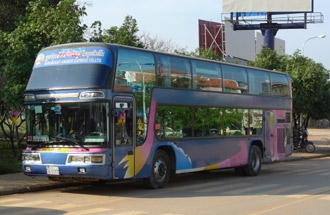 |
|
|
Angkor Paramount Express air-con bus. |
|
 |
|
|
Giant Ibis minibus from Phnom Penh to Sihanoukville. Courtesy of Maureen Spencer. |
PSD Express also run air-con buses at 08:30 & 14:30.
PSD Express also run air-con buses at 08:30 & 15:30.
In Phnom Penh, there is no centralised bus station. Mekong Express leaves from a terminal just out of town with a free minibus transfer from most hotels. Bus companies often offer a free transfer from your hotel.
The road distance is approximately 220 km (137 miles).
A third company also operates on this route, Angkor Paramount Express.
Feedback from booking & taking these buses appreciated!
How to buy tickets
-
Mekong Express can be booked online at reliable agency www.baolau.com which accepts international credit cards & issues e-tickets.
-
PSD Express can be booked online at reliable agency 12go.asia which accepts international credit cards & issues e-tickets.
-
Giant Ibis can be booked online at reliable agencies 12go.asia or www.baolau.com. Both accept international credit cards & issue e-tickets.
-
Or you can ask at your hotel or go to any local travel agency.
Phnom Penh - Kampot by bus
Also see the new train service above.
In Phnom Penh, there is no centralised bus station. Bus companies often offer a free transfer from your hotel.
To buy tickets, ask at your hotel or go to any local travel agency. Alternatively, try new Cambodian bus ticket reseller website www.camboticket.com. They sell tickets easily for a variety of bus operators with payment by international credit card and for some departures from Phnom Penh, cash on delivery. Feedback if you use them would be appreciated.
Visiting the Angkor temples
Cambodia's premier tourist attraction is the temple complex at Angkor, north of Siem Reap. Angkor Wat is the biggest and best-known temple, though there are many others. You really need a whole day to see the main ones, and several days to do the whole complex justice. You can buy entrance tickets on site or online at www.angkorenterprise.gov.kh.
The temples at Angkor are around 3km (2 miles) north of Siem Reap, you can hire a tuk-tuk or bicycles to take you there are around. You need to stop on the way at the ticket office. A one-day ticket for the whole Angkor temple complex costs $37 as from 2017. To visit Angkor Wat, make sure you wear 'respectful' clothing, meaning your shoulders are covered with a top with sleeves, and no shorts.
Europe to Cambodia by Trans-Siberian Railway
If you have the time (we're talking around 3 weeks one-way), you can travel from London to Phnom Penh overland, see the route map here. The links below cover travel in either direction, eastbound from London or westbound from Cambodia.
-
Step 1, London to Moscow by train. There are daily departures via Brussels, Berlin & Warsaw. The journey takes 2 nights, from around £250 one-way with sleeper. Trains to Russia were suspended due to Covid-19 and remain suspended due to sanctions & war in Ukraine.
-
Spend at least 1 night in Moscow.
-
Step 2, Moscow to Beijing by Trans-Siberian Railway. Two direct trains every week all year round, 6 nights. Fares from around £500 one-way with a bed in a 4-bed sleeper. Trains to China are suspended due to Covid-19.
-
Spend at least 1 night in Beijing.
-
Step 3, Beijing to Hanoi by train. There are two direct trains a week, 2 nights, about $320 or £220 one-way in soft sleeper. Alternatively, there are daily trains with a change in Nanning. Spend at least 1 night in Hanoi.
-
Step 4, Hanoi to Saigon by train. There are several comfortable air-conditioned trains every day over the Reunification Railway taking 2 nights. Why not stop off to see Hue or Hoi An? About $90 or £50 one-way in soft sleeper.
-
Step 5, Saigon-Phnom Penh by bus. There are lots of buses every day, journey time 6 hours, $12.
How to arrange this trip
-
There aren't any travel agencies who can arrange the whole trip, so you will need to plan it out and arrange each stage of the journey yourself. It's an exercise in project management! Unless time is absolutely no object, you should book the key sections in advance through various travel agencies.
-
Book London-Moscow as shown on the London to Russia page.
-
Book Moscow-Beijing & Beijing-Hanoi through a local Russian agency such as Real Russia, as shown on the Trans-Siberian page & Vietnam page.
-
Tickets for other parts of the trip, for example, Hanoi-Saigon-Phnom Penh-Bangkok can all be bought locally, as you go along. You'll need to pre-arrange visas for Belarus, Russia, possibly Mongolia, China & Vietnam, and in many ways complying with the various visa requirements (which sometimes require confirmed onward tickets to be held) is actually the biggest challenge, not buying the tickets, so check this out carefully using the relevant embassy websites.
-
Where do you start? First, read through the seat61 pages linked above. Then sketch out your itinerary using a simple spreadsheet like this, deciding where and for how long you want to stop off. Next, check out the visa situation for each country. Finally, follow the advice on each seat61 page to buy tickets for each train journey that you want to pre-book.
Some inspiration
You won't be the first to travel between Europe and Southeast Asia overland this way, far from it. Check out this excellent blog from Tom Woods, "Woodlands to Woking", woodlandstowoking.wordpress.com, and Matthew Woodward's equally excellent blog from Edinburgh to Singapore www.matthew-woodward.com/edinburgh-to-singapore.
Guidebooks


![]() To get the
most out of a trip to SE Asia, you'll need a good guidebook - and I have always
thought that the
Lonely Planet or Rough Guides are the best ones out there.
To get the
most out of a trip to SE Asia, you'll need a good guidebook - and I have always
thought that the
Lonely Planet or Rough Guides are the best ones out there.
Buy in the UK at Amazon.co.uk
Buy in the USA at Amazon.com
Alternatively, you can download just the chapters or areas you need in .PDF format from the Lonely Planet Website, from around £2.99 or US$4.95 a chapter.
Hotels in Cambodia
Recommended hotel: The Foreign Correspondents Club (FCC), Phnom Penh
This is a celebrated bar facing the river on Sisowath Quay, well known on the ex-pats circuit. But it's also a small hotel with nine rooms on the 1st floor, including a deluxe room at the front on the corner facing the river, and others at the back. It's a vibrant and well-located place to stay, maybe a bit noisy until they turn off the music around 10pm. With an excellent restaurant (try their Fish Ashok, a traditional Cambodian fish curry) and a great breakfast included in the room rate, this is a wonderful place to stay. A major renovation is in progress, it was due to reopen in 2023 but still not open in 2024.
Travel insurance & other tips
Always take out travel insurance
Never travel overseas without travel insurance from a reliable insurer, with at least £1m or preferably £5m medical cover. It should also cover cancellation and loss of cash and belongings, up to a sensible limit. An annual multi-trip policy is usually cheaper than several single-trip policies even for just 2 or 3 trips a year, I have an annual policy with Staysure.co.uk myself. Here are some suggested insurers. Seat61 gets a small commission if you buy through these links.
![]() www.staysure.co.uk
offers enhanced Covid-19 protection & gets 4.7 out of 5 on
Trustpilot.
www.staysure.co.uk
offers enhanced Covid-19 protection & gets 4.7 out of 5 on
Trustpilot.
![]() www.columbusdirect.com
is also a well-know brand.
www.columbusdirect.com
is also a well-know brand.
![]() If you live in the USA try
Travel Guard USA.
If you live in the USA try
Travel Guard USA.
Get an eSIM with mobile data package
Don't rely on WiFi, download an eSIM with a mobile data package for the country you're visiting and stay connected. Most newer mobile phones can download a virtual SIM card so you don't need to buy a physical SIM, including iPhone 11 & later, see device compatibility list. Maya.net is a reliable eSIM data retailer with a 4.5 out of 5 Trustpilot rating and a range of packages including unlimited data.
Get a Curve card for foreign travel
Most banks give you a poor exchange rate, then add a foreign transaction fee on top. A Curve MasterCard means no foreign transaction fees and gives you the mid-market exchange rate, at least up to a certain limit, £500 per month at time of writing. The money you spend on your Curve card goes straight onto one of your existing debit or credit cards.
How it works: 1. Download the Curve app for iPhone or Android. 2. Enter your details & they'll send you a Curve MasterCard - they send to the UK and most European addresses. 3. Link your existing credit & debit cards to the app, you can link up to two cards with the free version of Curve, I link my normal debit card and my normal credit card. 4. Now use the Curve MasterCard to buy things online or in person or take cash from ATMs, exactly like a normal MasterCard. Curve does the currency conversion and puts the balance in your own currency onto whichever debit or credit card is currently selected in the Curve app. You can even change your mind about which card it goes onto, within 14 days of the transaction.
I have a Curve Blue card myself, it means I can buy a coffee on a foreign station on a card without being stung by fees and lousy exchange rates, just by tapping the Curve card on their card reader. The money goes through Curve to my normal debit card and is taken directly from my account (in fact I have the Curve card set up as payment card on Apple Pay on my iPhone, so can double-click my phone, let it do Face ID then tap the reader with the phone - even easier than digging a card out). I get a little commission if you sign up to Curve, but I recommend it here because I think it's great. See details, download the app and get a Curve card, they'll give you £5 cashback through that link.
Get a VPN for safe browsing. Why you need a VPN
When you're travelling you often use free WiFi in public places which may not be secure. A VPN encrypts your connection so it's always secure, even on unsecured WiFi. It also means you can select the geographic location of the IP address you browse with, to get around geoblocking which a surprising number of websites apply. See VPNs & why you need one explained. ExpressVPN is a best buy with a 4.7 out of 5 Trustpilot ranking which I use myself - I've signed up as an ExpressVPN affiliate, and if you go with expressvpn.com using the links on this page, you should see a special deal, 3 months free with an annual subscription. I get a small commission to help support this site.
Carry an Anker powerbank
Tickets, reservations, vaccination records and Interrail or Eurail passes are often held digitally on your mobile phone, so it's vital to keep it charged. I always carry an Anker powerbank which can recharge my phone several times over if I can't get to a power outlet. Buy from Amazon.co.uk or from buy from Amazon.com.



